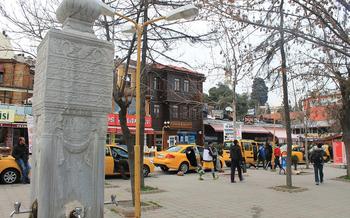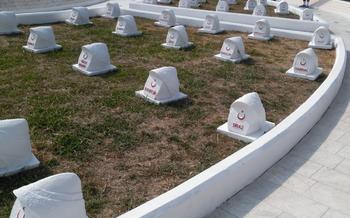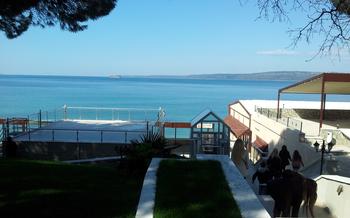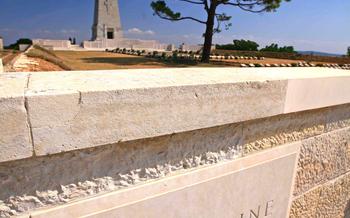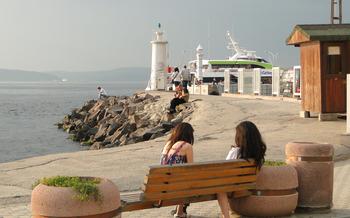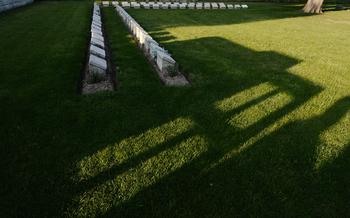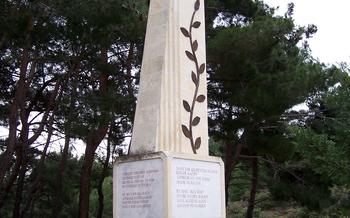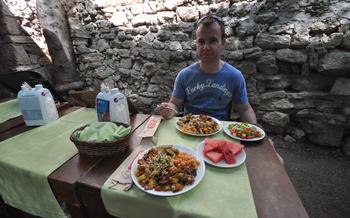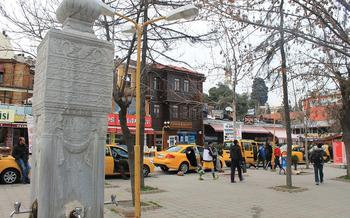
Gallipoli Battlefield Tours
- Gallipoli Battlefield Tours: A Journey Through History
- Must-See Sites:
- Lone Pine Cemetery:
- Nek Cemetery:
- Chunuk Bair Memorial:
- Anzac Cove:
- Unveiling the Anzacs' Story:
- A Glimpse into Turkish History
- Practicalities of Visiting Gallipoli
- A Day in the Trenches
- The Dawn Service
- Visiting the War Museums
- Connecting with Nature
- Paying Respects at Cemeteries
- Exploring the Dardanelles Straits: A Journey Through History
- Experiencing Local Culture
- A Journey of Remembrance
- Ethical Considerations
- Insider Tip: Unveiling Gallipoli's Essence in the Off-Season
Gallipoli Battlefield Tours: A Journey Through History
The Gallipoli Battlefield in Turkey is a poignant reminder of the sacrifices made during World War I. It holds immense historical significance as the site of the tragic Gallipoli Campaign, where Allied forces, primarily from Australia and New Zealand, attempted to seize control of the Dardanelles Straits from the Ottoman Empire. The campaign, which lasted from April 1915 to January 1916, resulted in heavy casualties on both sides.
As you explore the battlefields, you'll encounter remnants of trenches, tunnels, and artillery positions, offering a glimpse into the harsh realities of trench warfare. Wartime stories, recounted by veterans and historians, paint a vivid picture of the courage, resilience, and suffering experienced by the soldiers. Commemoration ceremonies, held annually on Anzac Day (April 25th), pay tribute to the fallen and honor the enduring legacy of the campaign.
Several tour options are available to visitors, ranging from guided tours led by experienced historians to self-guided explorations. These tours provide insightful commentary, allowing you to delve deeper into the events that unfolded during the Gallipoli Campaign.
Must-See Sites:
Lone Pine Cemetery:
Lone Pine Cemetery, with its rows of white headstones, stands as a solemn tribute to the fallen soldiers of the Gallipoli campaign. Here, you can pay your respects to the brave men who fought and lost their lives in the bloody battles of Lone Pine, and learn about the significance of this site in the wider context of the campaign.
Nek Cemetery:
Nek Cemetery, located near the Anzac Cove landing site, is another poignant reminder of the sacrifices made by the Allied forces during the Gallipoli campaign. This cemetery is the resting place of many Australian and New Zealand soldiers who lost their lives in the fierce fighting at the Nek, a small hill that became a strategic focal point during the campaign.
Chunuk Bair Memorial:
The Chunuk Bair Memorial commemorates the New Zealand soldiers who fought and died in the Battle of Chunuk Bair, one of the most significant engagements of the Gallipoli campaign. Perched atop a hill overlooking the Dardanelles Straits, the memorial offers stunning views of the surrounding landscape and serves as a poignant reminder of the bravery and sacrifice of the New Zealand troops.
Anzac Cove:
Anzac Cove, where the Australian and New Zealand forces first landed on Gallipoli, is a must-visit site for any visitor to the region. Here, you can explore the beaches and cliffs where the troops came ashore, and learn about the challenges they faced as they fought their way inland.
Unveiling the Anzacs' Story:
At the heart of the Gallipoli Battlefield Tours lies the story of the Anzacs, a term used to refer to the Australian and New Zealand Army Corps. Their heroic efforts during the Gallipoli Campaign have left an indelible mark on history, and their legacy is deeply intertwined with the spirit of remembrance and commemoration.
The landing of the Anzac forces at Anzac Cove on April 25, 1915, marked the beginning of a harrowing campaign that would span eight months. The rugged terrain, coupled with the relentless Turkish resistance, led to fierce battles that claimed the lives of thousands of soldiers.
The significance of Anzac Day, observed on April 25th each year, cannot be overstated. It is a day set aside to honor the bravery and sacrifice of the Anzacs and all those who fought in the Gallipoli Campaign. On this day, commemorative ceremonies are held at various sites across Gallipoli, including the poignant Dawn Service at Anzac Cove.
The Anzac Commemorative Site, located at the foot of the cliffs overlooking the cove, serves as a poignant reminder of the sacrifices made by the Anzac forces. The site features a number of memorials, including the Anzac Memorial, which bears the names of the fallen Anzacs, and the Lone Pine Memorial, dedicated to the soldiers who fought in the Battle of Lone Pine.
Visiting the Anzac Commemorative Site is an emotional and deeply moving experience, allowing visitors to connect with the stories of the Anzacs and pay their respects to those who fought and died during the Gallipoli Campaign.
A Glimpse into Turkish History
The Gallipoli Campaign holds immense significance in Turkish history, deeply intertwined with the rise of modern Turkey. During World War I, the Ottoman Empire, under the leadership of Mustafa Kemal Atatürk, valiantly defended the Gallipoli Peninsula against the Allied forces. Atatürk's strategic brilliance and leadership during the campaign earned him the title of "Father of the Turks" and played a crucial role in the establishment of the Republic of Turkey in 192
For the Turkish people, the Gallipoli Campaign is a symbol of national pride and resilience. It represents their unwavering determination to protect their homeland and their ability to overcome seemingly insurmountable odds. The Turkish perspective on the campaign often emphasizes the heroic efforts of their soldiers, their innovative tactics, and their ultimate victory in defending the peninsula.
Visiting Turkish memorials and learning about their experiences provides a deeper understanding of the complexities of the campaign and the lasting impact it had on the Turkish nation. These memorials honor the thousands of Turkish soldiers who lost their lives in the defense of Gallipoli, paying tribute to their bravery and sacrifice.
Practicalities of Visiting Gallipoli
Getting to Gallipoli:
Gallipoli is located on the Gallipoli Peninsula, which juts out into the Dardanelles Strait. The peninsula is easily accessible by ferry from the city of Çanakkale on the mainland. Ferries depart from Çanakkale several times a day, and the journey takes about 45 minutes.
Guided Tours vs. Self-Guided Exploration:
There are a number of tour operators that offer guided tours of the Gallipoli battlefields. These tours typically last for a full day and include visits to all of the major sites. Guided tours are a great option for those who want to learn more about the history of the campaign and who want to make sure they don't miss anything important.
However, it is also possible to explore the battlefields on your own. There are a number of well-marked trails that lead to all of the major sites. Self-guided exploration is a good option for those who want to go at their own pace and who want to avoid the crowds.
Accommodation Options:
There are a number of hotels and guesthouses located in Çanakkale. Visitors can also choose to stay in one of the many villages on the Gallipoli Peninsula. There are also a number of campsites located in the area.
Planning Your Itinerary:
When planning your itinerary for your visit to Gallipoli, it is important to consider the following factors:
- The time of year you are visiting. The weather in Gallipoli can be very hot and humid in the summer, so it is best to visit in the spring or fall.
- The length of time you have available. If you only have a day or two, you will need to prioritize your visits.
- Your interests. If you are particularly interested in the history of the campaign, you will want to spend more time visiting the battlefields. If you are more interested in the natural beauty of the area, you will want to spend more time hiking and swimming.
A Day in the Trenches
At Gallipoli, visitors have the unique opportunity to explore the meticulously preserved trenches, offering a glimpse into the challenging living conditions and harsh realities faced by the soldiers during the campaign. Delving into these underground tunnels and dugouts, you can almost feel the presence of the soldiers who once occupied them. The trenches provide a tangible connection to the past, allowing you to better understand the sacrifices and hardships endured by both sides of the conflict.
One of the most poignant experiences is visiting the John Quinn's trench, named after an Australian soldier who survived the Gallipoli campaign. This well-preserved trench offers a glimpse into the soldiers' daily lives, with bunks, cooking areas, and storage spaces still visible. As you explore these confined spaces, you can't help but contemplate the courage and resilience of the men who spent months living and fighting in such challenging conditions.
The Dawn Service
The dawn service holds immense significance in the commemoration of the Gallipoli Campaign. It is a moving ceremony that honors the fallen soldiers and pays tribute to their sacrifice. The service typically begins before sunrise, symbolizing the start of the landings on April 25, 19
As the first rays of light illuminate the tranquil waters of Anzac Cove, a hush falls over the gathered crowd. The stillness of the morning is broken by the haunting sound of the bugle, signaling the start of the service. The Last Post echoes through the air, a poignant reminder of the lives lost in the war.
The service includes readings from scriptures, prayers, and hymns, all of which serve to honor the memory of those who fought and died at Gallipoli. The roll of honor is read, listing the names of the fallen soldiers, a solemn reminder of the immense sacrifice made by so many.
The dawn service is not just a commemoration of the past; it is also a time for reflection and remembrance. It is an opportunity to honor the courage and resilience of the soldiers who fought in the Gallipoli Campaign, and to pay tribute to the enduring legacy of the ANZAC spirit.
Attending the dawn service at Anzac Cove is a profound and moving experience that allows visitors to connect with the history and significance of the Gallipoli Campaign on a deeply personal level. It is a chance to remember the fallen, honor their sacrifice, and reflect on the impact of war.
Tips for Attending the Dawn Service:
- Arrive early to secure a good spot and avoid the crowds.
- Dress warmly as the mornings can be chilly.
- Bring a torch or flashlight to help you navigate in the dark.
- Be respectful and silent during the service.
- Take time after the service to reflect and pay your respects at the Lone Pine Cemetery.
Visiting the War Museums
There are two prominent museums in the Gallipoli region that offer a deeper understanding of the campaign's history and significance: the Gallipoli Historical Museum and the Çanakkale Martyrs' Museum.
The Gallipoli Historical Museum, located in Eceabat, houses an extensive collection of artifacts, documents, and photographs that chronicle the Gallipoli Campaign from both the Allied and Turkish perspectives. Visitors can learn about the planning and execution of the campaign, as well as the daily lives of the soldiers on both sides. The museum also hosts temporary exhibitions and educational programs throughout the year.
The Çanakkale Martyrs' Museum, situated in the city of Çanakkale, focuses on the Turkish perspective of the campaign. It showcases exhibits on the Ottoman Empire's involvement, the role of Mustafa Kemal Atatürk, and the sacrifices made by the Turkish soldiers. The museum also features a poignant memorial hall dedicated to the fallen Turkish soldiers, where visitors can pay their respects.
Both museums offer a valuable opportunity to delve deeper into the historical context of the Gallipoli Campaign and gain a better understanding of the experiences of the soldiers who fought there.
Connecting with Nature
Gallipoli offers not only historical significance but also stunning natural beauty. The ANZAC Trail is a must-do for outdoor enthusiasts, offering a scenic walking route along the Gallipoli Peninsula. The trail takes you through rugged terrain, panoramic views of the Dardanelles Straits, and significant historical sites.
Brighton Beach is another natural gem of Gallipoli. Located near Anzac Cove, this pristine beach invites you to take a refreshing dip in the Aegean Sea. The turquoise waters and sandy shores create a peaceful ambiance, making it an ideal spot to relax and soak in the natural beauty of the region.
Gallipoli National Park encompasses the entire peninsula and offers a diverse range of landscapes. From lush forests to rugged cliffs, the park is a haven for nature lovers. Hiking enthusiasts can explore the park's numerous trails, discovering hidden coves, panoramic viewpoints, and abundant wildlife.
As you explore the natural wonders of Gallipoli, take time to appreciate the breathtaking scenery. The combination of history and nature creates a unique and awe-inspiring experience that will leave a lasting impression.
Paying Respects at Cemeteries
Lone Pine Cemetery: Amidst the tranquility of the Gallipoli Peninsula, Lone Pine Cemetery stands as a hallowed ground, paying tribute to the valiant Australian and New Zealand soldiers who sacrificed their lives during the Great War. Wander through the rows of pristine white headstones, each adorned with the names and stories of the fallen. Take a moment to contemplate the immense courage and sacrifice displayed by these young men who fought with unwavering determination.
Chunuk Bair Cemetery: Ascend to the hilltop of Chunuk Bair, where the Chunuk Bair Cemetery overlooks the vast expanse of the battlefield. Here, beneath the watchful gaze of the towering obelisk, lie the remains of Turkish soldiers who fiercely defended their homeland. Their unwavering bravery and resilience are etched into the very soil of this sacred site. Pay your respects to these heroes who fought with unwavering resolve for their nation.
Respecting the Fallen Soldiers: As you traverse the hallowed grounds of these cemeteries, let a sense of reverence guide your steps. Remember that you are walking amidst the final resting places of those who paid the ultimate price for their beliefs. Honor their memory by maintaining a respectful demeanor, observing silence, and refraining from disturbing the serenity of these sacred spaces.
Reflecting on the Sacrifices: Take a moment to pause and reflect upon the immense sacrifices made by the soldiers of both sides during the Gallipoli Campaign. Their selfless acts of courage and devotion serve as a poignant reminder of the horrors of war and the futility of conflict. Let their stories inspire you to foster peace, understanding, and reconciliation among nations.
Exploring the Dardanelles Straits: A Journey Through History
The Dardanelles Straits, a narrow waterway connecting the Aegean and Black Seas, holds immense historical and strategic significance. During the Gallipoli Campaign, the straits were the scene of intense naval battles between the Allied forces and the Ottoman Empire. A ferry ride across the straits offers a unique perspective of the Gallipoli Peninsula and the surrounding landscape.
The Dardanelles War Memorial, located on the Asian side of the straits, commemorates the Turkish soldiers who lost their lives during the campaign. The memorial features a poignant statue of a Turkish soldier gazing across the straits towards the Gallipoli Peninsula. Visitors can also explore the nearby museum, which houses exhibits and artifacts related to the campaign.
Understanding the strategic importance of the Dardanelles Straits is crucial for comprehending the significance of the Gallipoli Campaign. The straits served as a vital gateway for trade and military operations, and controlling them meant controlling access to the Black Sea and beyond. The Allied forces aimed to capture the straits and open a supply route to Russia, their ally in World War I.
The scenic views from the ferry or the war memorial are breathtaking. The tranquil waters of the straits, framed by the lush green hills of the Gallipoli Peninsula, create a picturesque panorama. Visitors can admire the natural beauty of the region while contemplating the historical events that unfolded here over a century ago.
Experiencing Local Culture
Beyond the battlefields, Çanakkale offers a rich cultural tapestry waiting to be explored. The city of Çanakkale, situated on the shores of the Dardanelles, exudes a vibrant energy with its charming streets, traditional markets, and bustling harbor.
1 Indulge in Turkish Cuisine:
Tantalize your taste buds with the delectable flavors of Turkish cuisine. Savor the succulent grilled meats, freshly caught seafood, and an array of mezze platters. Don't miss the chance to try the local specialty, "Çanakkale Sardalya," a grilled sardine dish that captures the essence of the region's culinary heritage.
2 Engage with the Locals:
The people of Çanakkale are renowned for their warm hospitality and friendly nature. Take the time to interact with the locals, learn about their customs, and share stories. Visit the local tea gardens, where you can sip on traditional Turkish tea and engage in lively conversations.
3 Explore Turkish Traditions:
Discover the vibrant Turkish traditions that are deeply rooted in the region. Witness the mesmerizing performances of traditional folk dances, marvel at the intricate art of carpet weaving, and immerse yourself in the soulful melodies of Turkish music.
4 Shop for Local Treasures:
Stroll through the bustling markets and bazaars, where you can find an array of local treasures and souvenirs. Haggle for unique handmade crafts, colorful textiles, and aromatic spices that will transport you back to the vibrant atmosphere of Çanakkale.
A Journey of Remembrance
Gallipoli is not just a battlefield; it's a place of deep historical significance, a testament to the sacrifices made by soldiers from all nations. Visiting Gallipoli is a journey of remembrance, an opportunity to connect with history on a deeper level and understand the profound impact of war.
As you walk through the battlefields, read the headstones, and listen to the stories of the fallen soldiers, you'll be struck by the futility of war. Here, in this small corner of Turkey, young men from all over the world lost their lives in a conflict that ultimately achieved very little.
The Gallipoli Campaign was a turning point in the First World War, but it was also a tragedy. Thousands of young men, filled with hope and idealism, were sent to their deaths in a war that was ultimately unwinnable. It's important to remember these young men and the sacrifices they made.
Visiting Gallipoli is a chance to reflect on the horrors of war and the importance of peace. It's a place to remember the fallen soldiers and honor their memory. It's a place to learn from the past and work towards a future where war is no longer an option.
Ethical Considerations
As you explore the Gallipoli Battlefield, it is crucial to be mindful of the ethical considerations that accompany such a visit. The battlefield is a place of immense historical significance and a final resting place for thousands of soldiers. As visitors, we have a responsibility to respect the site and its somber atmosphere.
-
Respect the Battlefield Sites: Tread carefully and avoid disturbing the landscape. Refrain from touching or removing any artifacts or relics, as they are protected by law.
-
Preserve the Historical Integrity: Do not climb on or deface any monuments, memorials, or trenches. Respect the sanctity of the site by maintaining a respectful demeanor and avoiding loud or disruptive behavior.
-
Support Local Initiatives: Consider supporting local organizations and initiatives that work to preserve the battlefield and promote responsible tourism. Your contributions can help ensure the site's long-term protection and conservation.
-
Promote Responsible Tourism: Share your experiences with others while emphasizing the importance of respecting the battlefield. Encourage fellow travelers to adopt responsible behavior and support local businesses that operate ethically.
Insider Tip: Unveiling Gallipoli's Essence in the Off-Season
While the allure of Gallipoli beckons travelers year-round, venturing during the tranquil off-season offers a unique and enriching experience. The crowds dissipate, leaving you with an intimate encounter with history. Stroll through the serene battlefields, unhurried by the throngs, and immerse yourself in the poignant stories that linger in the air. Embrace the solitude, allowing for deeper contemplation and a more profound connection with the site's significance. Additionally, take advantage of discounted rates on accommodation and tours, making your pilgrimage to Gallipoli both budget-friendly and deeply rewarding.
